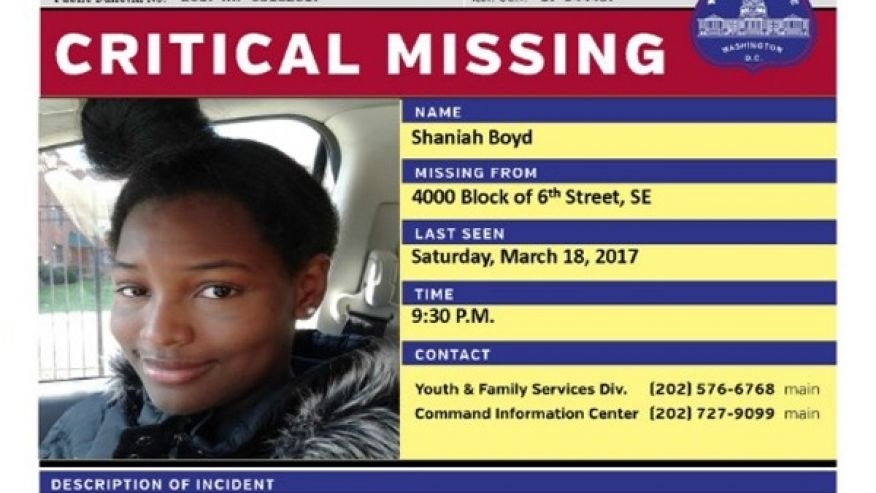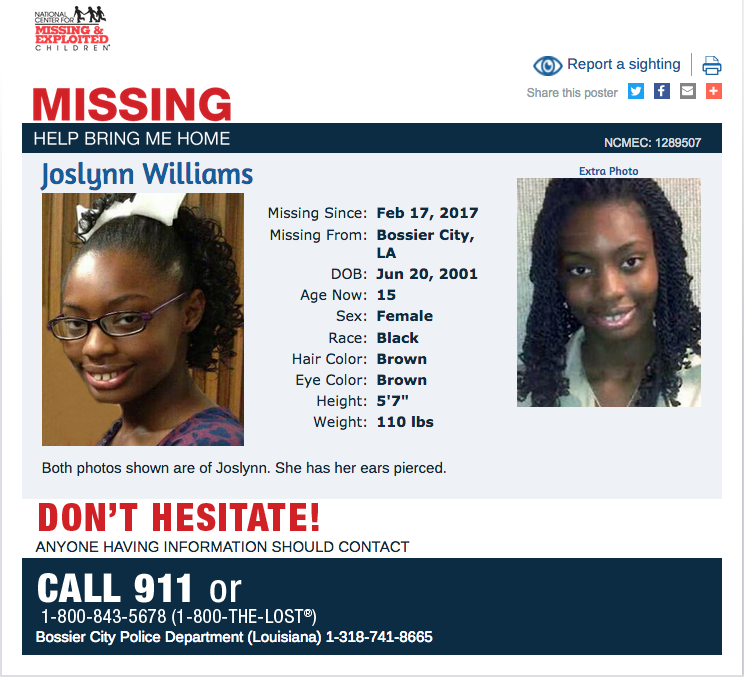
C R Sparrow wants desperately to throw off the shackles…
The story of the missing Black girls from the Washington DC area is complex and ever changing. For one thing, it is still developing as new information comes to light. Another issue complicating the narrative is that key details which led to the public outcry were not completely accurate, which has led to a great deal of panic and confusion. What is important to keep in mind is that at the core of this issue are vulnerable young people who need our help and deserve out attention.
The story, which had already been simmering for weeks, seemed to pick up steam late last week around the time that NBC 4, the DC affiliate, posted the Tweet below. The text reads: “As of Thursday, a dozen D.C. teens, ranging in age from 14 to 18, are missing.” A map featuring the last known locations of these missing children is linked.
RT: As of Thursday, a dozen D.C. teens, ranging in age from 14 to 18, are missing. https://t.co/mmzfk1kwaL
This map is updated daily
— NBCWashington (@nbcwashington) March 23, 2017
While the post and map were designed to track missing youth from the beginning of this year, somehow the spread of this post and other posts by DC police regarding missing children morphed into a report about fourteen girls going missing in a single day. Understandably alarmed, many took to their social networking accounts as a way to put pressure on the mainstream media for coverage, and the hashtag #missingDCgirls was born. The spread of the story can be attributed to the many concerned celebrities who used their vast reach to inform the masses. LL Cool J, for instance, doggedly contacted other entertainers and national news organizations on Twitter, appealing to them for a response.
According to NBC 4’s follow-up report, Washington DC Police assure the public that their increased use of social media to find missing children is not indicative of an increase in actual children who have gone missing, but a new tactic in combating the problem. They assert that at no point in recent weeks have fourteen girls gone missing in one day. The Center For Exploited and Missing Children corroborated that there has been no significant increase.
The tone of the piece was grave and respectful, but the priority was allaying public panic and ‘debunking a fake report’ sending concerned citizens to their news app and heated town hall meetings in droves, demanding answers. At this point, many a concerned citizen might breathe a sigh of relief and move onto the next tragedy, but it’s important that we examine a few things first.
The proverbial elephant in the room is that the gulf between what should be and what is is so wide that relying on society’s mechanisms for dealing with crises in Black communities seems almost foolhardy. It’s hard to take mainstream media at face value and not pick apart their motives based on their crucial role in maintaining and fostering white supremacy in our society.
In the aforementioned coverage, a full half of it is devoted to the case of 17-year-old Katherine Hunter who ran away from home and who has been reunited with her family alive and well. It is alluded to that there are ongoing difficulties at home, which is the reason for her flight. The segment relied heavily on her mother’s emotional trauma over the situation. At the end of the segment, the reporter states that according to Katherine the missing DC youth “simply want out,” followed by a clip of Katherine saying “They’re leaving. They don’t know what they’re looking for. They don’t know what they’re trying to find.”
Katherine’s story is real and valid and needs to be heard, but I can’t help but wonder how the average watcher will process this segment. Shifting a heated public conversation about finding and protecting vulnerable children to characterizing said children as going on unauthorized walkabouts, even with soft and understanding tones, is quite the reversal. And it dismisses young children or those who were coerced, tricked, or abducted. There is no mention of the young Black children who go missing, and no Amber Alert is issued because according to the authorities, they don’t fit the criteria.
TMZ was not even that subtle; their headline reads D.C. Missing Girls: Cops Say They’re Runaways Not Crime Victims. Nothing to see here folks, case closed—even though inside the article a police spokesperson cannot say for certain whether this theory is true or not. I have so many questions, like when did being a runaway and the victim of a crime become mutually exclusive? Wouldn’t a child who found themselves out on the street no matter the circumstances, be at a higher risk for exploitation and crime? How long did this new narrative take to formulate in their newsroom?
For good or for ill, it’s important to note that for several days a large cross section of Americans have been discussing the wellbeing of young Black girls and forced the mainstream media to do the same. Was it the case of some crafty individual being purposely hyperbolic to force everyone’s attention on a very real threat? One may never know, but now that this issue has eyes on it, lawmakers are trying to make the best of it. Mayor Murial Bowser has announced new procedures for dealing with missing children cases including assigning more police to this beat. The Associated Press reports that Reps in the Congressional Black Caucus are calling on Attorney General Jeff Sessions and FBI Director James Comey to “devote the resources necessary to determine whether these developments are an anomaly or whether they are indicative of an underlying trend that must be addressed.”
Sessions.
This is the same man who deemed the NAACP un-American with how they force civil rights down the throats of white Americans. That’s the guy who is supposed to bring our lost Black and Brown children back to us. Sessions, who was appointed by a president who has publically lusted after his young daughter and who bragged about skulking around women’s locker rooms as the owner of beauty pageants, is on the case. I feel less at ease. According to CNN, Sessions has been briefed on the situation. Let’s hope he doesn’t criminalize running away and collect our children in some big sweep.
 All is not lost. There is the work of Derrica Wilson’s nonprofit organization, Black and Missing. Before this was a national conversation, BaM was already prioritizing the oft-neglected missing Black adults and children of this country. Law enforcement may be stingy with its Amber Alerts; news media may have its questionable agendas; and those charged with serving, protecting, and finding lost children may have the opposite in mind, but we have each other. Keep sharing those posters. Keep an eye out for the telltale signs of trafficking. Donate if you can. Put pressure on your local government to treat our children’s disappearances like a priority, not an afterthought. Mentor youth in your area. Get all the way in your kids’ business.
All is not lost. There is the work of Derrica Wilson’s nonprofit organization, Black and Missing. Before this was a national conversation, BaM was already prioritizing the oft-neglected missing Black adults and children of this country. Law enforcement may be stingy with its Amber Alerts; news media may have its questionable agendas; and those charged with serving, protecting, and finding lost children may have the opposite in mind, but we have each other. Keep sharing those posters. Keep an eye out for the telltale signs of trafficking. Donate if you can. Put pressure on your local government to treat our children’s disappearances like a priority, not an afterthought. Mentor youth in your area. Get all the way in your kids’ business.
Another related issue is the role that commonplace LGBTQ related oppressions have on the psyche of LGBTQ youth. Does that seem out of left field? Well, it shouldn’t since approximately 40% of homeless youth identify as LGBTQ. Making sure that the homes, schools and other community gathering spaces are physically and emotionally safe for them might help keep our children at home as well.
At the end of the day, we need to do everything in our power to protect our children because if we don’t, no one else will.
Contact Black & Missing
Contact National Center For Missing & Exploited Children
What's Your Reaction?
C R Sparrow wants desperately to throw off the shackles of wage slavery and live a life of leisure. Unfortunately, she hasn’t quite figured out how to turn her encyclopedic knowledge of Star Trek Deep Space Nine or deftness at playing Bioware RPGs on the easiest setting into a fortune. She’s still working on it though. Sci-fi/Fantasy blerd with a strong affinity for binging television shows and having lots of feelings about them.











